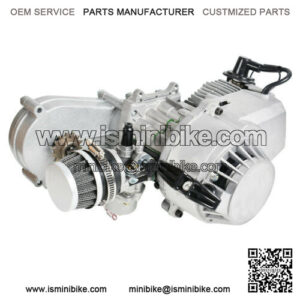We have all been exposed mostly to one type of bike engine i.e. Single cylinder engine found in most of the motorcycles. But there is lots of variety in type of engines that are used in motorcycles. Know what they are? Read on.
Commonly found motorcycle engine types are:
- Single cylinder engines
- Two cylinder engines
- Triple cylinder engines
- Four cylinder engines
- Six cylinder engines
1. Single cylinder engines :
Single cylinder engines work best on small cc bikes. They are cheap to maintain and fix if something goes wrong. So you will find them across all commuter bike range like Splendor, Platina and even Yamaha R15.
You may have heard the term “Pushrod Engine”. It is a type of single cylinder engine. It used to be found in Royal Enfield earlier. In Pushrod engines, the camshaft sits in-between the cylinder heads of the engine. The crankshaft is connected to the camshaft via a chain or gear system, so that when the crankshaft turns the camshaft follows. When the camshaft turns, a lifter pushes a pushrod that opens and closes the engine’s valves. This engine benefits from higher torque at lower rpm but fails to reach higher rpm.
Pros: compact size, lightweight, inexpensive, high torque at low revs.
Cons: high vibrations, difficult balancing.
2. Two cylinder engines :
As you can guess from the name, this type of engine has two cylinders. More cylinders means more weight, more cost and of course, more power. Let’s look at types of two cylinder engines.
- Parallel Twin Engine:
Parallel-twin is a two-cylinder engines where both cylinders are arranged in a line (Side by side) along a common crankshaft. This type of engine is generally in medium and high displacement models. You can find examples of these engines in Kawasaki Ninja 300,650, RE Interceptor 650.
Pros: comfort, fluid operation, high performance, good balance.
Cons: higher vibrations than some others on this list.
- V-Twin Engine:
A V-twin engine is a two-cylinder piston engine where the cylinders share a common crankshaft and are arranged in a V configuration. As the name suggests, the arrangement of the two-cylinders forms a “V”. Although widely associated with motorcycles (installed either transversely or longitudinally), V-twin engines have also been used for industrial engines and in several small cars. You can find these engines mostly in Harleys.
Pros: good power/size ratio, lightweight.
Cons: higher vibrations than parallel twin engine, difficulty in balancing (narrow V angle).
- L Twin:
L twin engines are twin cylinder engines that have 90% angle between the cylinders. These engines are fairly similar to V twin engines in power, weight. Ducati made the L twin engines famous by using them in most of their range.
Pros & Cons: Same as V twin engines.
- Boxer Engine:
Boxer engines are also known as “Flat twin engines”. Most flat engines use a “boxer” configuration, where each pair of opposing pistons move inwards and outwards at the same time, somewhat like boxing competitors punching their gloves together before a fight.
Boxer engines have low vibrations, since they are the only common configuration that have no unbalanced forces regardless of the number of cylinders. Boxer engines therefore do not require a balance shaft or counterweights on the crankshaft to balance the weight of the reciprocating parts. These legendary engines are found on many BMW models like 1250GS.
Pros: excellent air cooling, good balancing.
Cons: As the cylinder protrude out, you can’t lean the bike to the max.
3. Triple cylinder engines :
A straight-three engine (also called an inline-triple or inline-three) is a three-cylinder piston engine where cylinders are arranged in a line along a common crankshaft.
These engines were developed as a middle ground between a V-twin and an inline-four engine. Triple cylinder engines are a lot smoother compared to a V-twin and is narrower & lighter than an inline-four. They also provide torque like a twin cylinder and power like inline 4. These engines are not found in many motorcycles except Triumph range like street triple and in Yamaha MT-09.
Pros: comfort, fluid operation, high performance.
Cons: more vibrations than inline4.
4. Four cylinder engines :
Now this is the range that all Indians go mad for. If you have grown up hearing the intoxicating exhaust sound, it was most probably an inline 4 engine exhaust. There are several types of four cylinder engines. Let’s have a look at them.
- Inline Four Engine:
The straight or inline 4 engine is an engine with all cylinders aligned in one row and having no offset. In-line 4 engines are also smaller in overall physical dimensions than designs and can be mounted in any direction. Straight configurations are simpler than their V-shaped counterparts. This was the exhaust sound that you used to identify as a superbike sound.
Pros: high power, good balancing, very low vibrations.
Cons: large overall dimensions and heavier than twin or triple engines.
- V-Four Engine:
A V4 engine is a four-cylinder piston engine where the cylinders share a common crankshaft and are arranged in a V configuration.V4 engines are much less common than inline-four engines. V4 include a shorter length and— when a 90-degree V-angle is used with the optimal firing interval— perfect primary balance which reduces vibration.
Pros: overall dimension, high performance, good balancing, low vibrations.
Cons: complexity in construction.
5. Straight six Engine :
These engines are like flat-twin (boxer engines) but with more cylinders. These engines are fairly rare and almost never seen outside of large touring models. A modern example of a flat-six would be Honda’s Gold Wing which has three-cylinders laid out horizontally on either side of the engine.
Pros: Extremely smooth in operation, oodles of torque
Cons: Expensive and heavier
About bike engine
“Keyword”
“bike engine oil”
“bike engine kit”
“bike engine oil price”
“bike engine oil price 1ltr”
“bike engine parts”
“bike engine car conversion kit”

